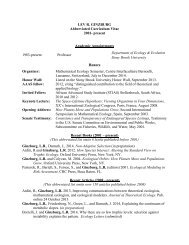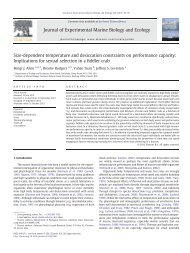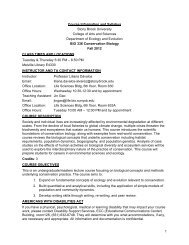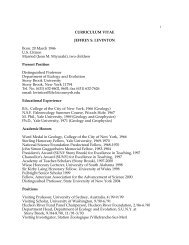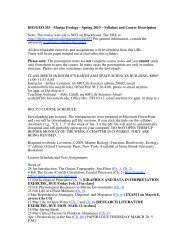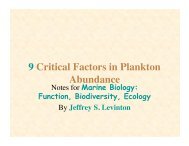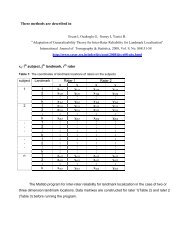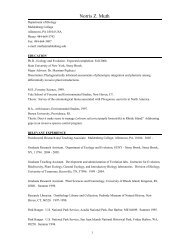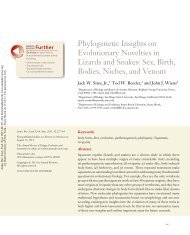Curriculum Vitae John J. Wiens - Stony Brook University
Curriculum Vitae John J. Wiens - Stony Brook University
Curriculum Vitae John J. Wiens - Stony Brook University
Create successful ePaper yourself
Turn your PDF publications into a flip-book with our unique Google optimized e-Paper software.
<strong>Wiens</strong>-C.V. page 1 of 24<br />
<strong>Curriculum</strong> <strong>Vitae</strong><br />
<strong>John</strong> J. <strong>Wiens</strong><br />
Present address:<br />
Department of Ecology and Evolution<br />
<strong>Stony</strong> <strong>Brook</strong> <strong>University</strong><br />
<strong>Stony</strong> <strong>Brook</strong>, NY 11794-5245<br />
e-mail: wiensj@life.bio.sunysb.edu<br />
Phone: 631-632-1101<br />
FAX: 631-632-7626<br />
Web-page: http://life.bio.sunysb.edu/ee/wienslab/homepage.html<br />
Research interests:<br />
(1) Phylogenetic approaches to evolution and ecology<br />
(2) Systematic theory and methodology<br />
(3) Phylogeny, evolution, and ecology of reptiles and amphibians<br />
23 March 2012<br />
Education:<br />
The <strong>University</strong> of Kansas, B.S. in Systematics and Ecology, 1991<br />
Senior Honors Thesis: “Phylogenetic position and relationships of the tree<br />
lizards (genus Urosaurus)”<br />
Supervisor: William E. Duellman<br />
The <strong>University</strong> of Texas at Austin, Ph.D. in Zoology, 1995<br />
Dissertation Title: “Phylogeny of the lizard genus Sceloporus: Systematics,<br />
evolutionary morphology, and evaluation of phylogenetic approaches.”<br />
Supervisors: David C. Cannatella and David M. Hillis<br />
Professional experience:<br />
2006–present, Associate Professor, Department of Ecology and Evolution,<br />
<strong>Stony</strong> <strong>Brook</strong> <strong>University</strong><br />
2003–2006, Assistant Professor, Department of Ecology and Evolution, <strong>Stony</strong><br />
<strong>Brook</strong> <strong>University</strong><br />
2001–2002, Associate Curator, Section of Amphibians and Reptiles, Carnegie<br />
Museum of Natural History<br />
1995–2001, Assistant Curator, Section of Amphibians and Reptiles, Carnegie<br />
Museum of Natural History<br />
2000–2002, Supervisor, Molecular Systematics Laboratory, CMNH<br />
1996–2001, Adjunct Professor, Department of Biology, <strong>University</strong> of Pittsburgh<br />
1991–95, NSF Graduate Fellow, <strong>University</strong> of Texas at Austin.<br />
1993–94, Graduate Teaching Assistant, <strong>University</strong> of Texas at Austin.<br />
1987–91, Undergraduate Research Assistant, Division of Herpetology,<br />
<strong>University</strong> of Kansas Museum of Natural History.<br />
Teaching experience:<br />
Herpetology (Bio 348; Undergraduate; “Diversity and evolution of reptiles and<br />
amphibians”), <strong>Stony</strong> <strong>Brook</strong> <strong>University</strong>, spring 2006, 2007, 2008, 2009, 2011
<strong>Wiens</strong>-C.V. page 2 of 24<br />
Evolution (BEE 551; Graduate level), <strong>Stony</strong> <strong>Brook</strong> <strong>University</strong>, fall 2004, 2005,<br />
2007, 2008, 2009<br />
Evolution (BIO 354; Undergraduate), <strong>Stony</strong> <strong>Brook</strong> <strong>University</strong>, fall 2003, 2005,<br />
2007, 2009<br />
Graduate seminar on evolutionary and ecological responses to climate change,<br />
<strong>Stony</strong> <strong>Brook</strong> <strong>University</strong>, fall 2011<br />
Graduate seminar on evolution and species interactions, <strong>Stony</strong> <strong>Brook</strong><br />
<strong>University</strong>, spring 2007<br />
Graduate seminar on species richness, <strong>Stony</strong> <strong>Brook</strong> <strong>University</strong>, spring 2003<br />
Phylogenetics, <strong>University</strong> of Pittsburgh, fall 1996, 2000<br />
Herpetology, Pymatuning Laboratory of Ecology, <strong>University</strong> of Pittsburgh,<br />
summer 1996<br />
Teaching Assistant for: Herpetology, Comparative Anatomy, Structure and<br />
Function of Organisms (Univ. Texas; 1993-1994)<br />
Graduate student direction:<br />
Shea Lambert (Ph.D. program, <strong>Stony</strong> <strong>Brook</strong>, started fall 2011)<br />
Antonin Machac (Ph.D. program, <strong>Stony</strong> <strong>Brook</strong>, started fall 2011)<br />
Xia Hua (Ph.D. program, <strong>Stony</strong> <strong>Brook</strong>, started fall 2007)<br />
Margaret-Caitlin Fisher-Reid (Ph.D. program, <strong>Stony</strong> <strong>Brook</strong>, started fall 2006)<br />
Dan Moen (Ph.D. program, <strong>Stony</strong> <strong>Brook</strong>, started fall 2004)<br />
Patrick Stephens (Ph.D., <strong>Stony</strong> <strong>Brook</strong>, 2005); currently Research Assistant<br />
Professor at Univ. Georgia<br />
Nathan Butler (M.A., <strong>Stony</strong> <strong>Brook</strong>, 2011)<br />
Allison Onstine (M.A., <strong>Stony</strong> <strong>Brook</strong>, 2011)<br />
Carolina Ulloa (M.A., <strong>Stony</strong> <strong>Brook</strong>, 2011)<br />
Christina Wolfe (M.A., <strong>Stony</strong> <strong>Brook</strong>, 2004)<br />
Dissertation committee: Charles Welsh, Univ. of Pittsburgh, Ph.D. 1997; <strong>Stony</strong><br />
<strong>Brook</strong>: Mireya Mayor, Ph.D. 2008 (Dept. Anthropology); Shu-Dan Yeh,<br />
Ph.D. 2009 (Dept. Ecology & Evolution). External: James Austin, Queens<br />
Univ., Ph.D. 2003 (now Assistant Professor, Univ. Florida); Frank<br />
Fontanella, City Univ. New York, Ph.D. 2009; Alex Pyron, City Univ. New<br />
York, Ph.D. 2009; Allyson Fenwick-Modra, Univ. Central Florida; Daniel<br />
Scantlebury, Rochester Univ.<br />
Postdoctoral direction:<br />
Alex Pyron (2009–2010); currently Assistant Professor, George Washington<br />
<strong>University</strong><br />
Windsor Aguirre (2007–2009); currently Assistant Professor, DePaul<br />
<strong>University</strong><br />
Kenneth Kozak (June 2005–June 2007); currently Assistant Professor,<br />
<strong>University</strong> of Minnesota<br />
Sarah Smith (January 2004–July 2006); currently living in Australia<br />
Tag Engstrom (2003–2004); currently Assistant Professor, California State<br />
<strong>University</strong> at Chico<br />
James Fetzner (2001–2002); currently Assistant Curator, Invertebrate Zoology,<br />
Carnegie Museum of Natural History<br />
Robert Espinoza (2000–2001); currently Professor, California State <strong>University</strong><br />
at Northridge
<strong>Wiens</strong>-C.V. page 3 of 24<br />
Christopher Parkinson (2000–2001); currently Associate Professor, <strong>University</strong><br />
of Central Florida<br />
Visiting foreign students (partial list):<br />
Pablo Guerrero (Chile; Fullbright Fellow)--2010<br />
Serkan Gul (Turkey)--2010–2011<br />
Thomas Blankers (Netherlands)--2011<br />
Greta Carrete-Vega (Spain)--2011<br />
Rubi Nelsi Meza-Lazaro (Mexico)--2011<br />
Ignacio Quintero (Colombia)--2011<br />
Field experience:<br />
Approximately 12 months over various trips to Mexico, Ecuador, Peru,<br />
Argentina, Brazil, Panama, Malaysia, India, and Taiwan. Extensive experience<br />
in the U.S.<br />
Professional service:<br />
Editor-in-Chief, Quarterly Review of Biology, 2007–2010<br />
Editor, Quarterly Review of Biology, 2006–2007, 2010–present<br />
Editor (Editorial Board), Ecology Letters, 2009–present<br />
Associate Editor, BMC Evolutionary Biology, 2011–present<br />
Associate Editor, Ecography, 2007–2009<br />
Associate Editor, American Naturalist, 2005–2009<br />
Associate Editor, Evolution, 2001–2003<br />
Associate Editor, Systematic Biology, 1996–2000<br />
Associate Editor, Herpetologica, 1996–2000<br />
Editorial Board, Systematic Biology, 1995–1996<br />
Editorial Board, Copeia, 1999–2008<br />
Editorial Board, Journal of Herpetology, 2001–present<br />
Editorial Advisory Board, Revista Mexicana de Biodiversidad, 2005–present<br />
Guest Editor, Proceedings Natl. Academy of Sciences, U.S.A. (2010)<br />
Ad Hoc Associate Editor, Conservation Biology (2007)<br />
Web-based journals:<br />
Board of Moderators, PLoS Currents: Tree of Life, 2010–present<br />
Editorial Board, Journal of Earth Science and Climate Change, 2010–present<br />
Editorial Board, Open Journal of Genomics, 2011–present<br />
Editorial Board, The International Journal of Ecology, 2008-present<br />
Editorial Board, The Open Conservation Biology Journal, 2008-present<br />
Editorial Board, The Open Medical Informatics Journal, 2008-present<br />
Editorial Board, The Open Evolution Journal, 2007–present<br />
Editorial Board, Research Letters in Ecology, 2007–2009<br />
Council, Society of Systematic Biologists (2003–2005)<br />
Long-Range Planning Committee, Society of Systematic Biologists (2007–2009)<br />
Board of Governors, American Society of Ichthyologists and Herpetologists<br />
(2003-2008)<br />
Rosemary Grant Award Committee, Society for the Study of Evolution (2011)
<strong>Wiens</strong>-C.V. page 4 of 24<br />
Invited Participant, NSF Workshop on Integrative Biogeography, Spring 2007<br />
Invited Participant, NSF Workshop on the Tree of Life, Spring 2008<br />
Invited Participant, NCEAS workshop on “Niche conservatism and diversity<br />
gradients,” Fall 2008, 2009<br />
NSF Systematic Biology Panel, Fall 2000<br />
NSF Biotic Surveys and Inventory Panel, Spring 2002<br />
NSF Doctoral Dissertation Improvement Grants, Spring 2003<br />
NSF Evolutionary and Population Ecology Panel, Fall 2004<br />
NSF Evolutionary and Population Ecology Panel, Fall 2005<br />
NSF Systematic Biology Panel, Fall 2007<br />
NSF Evolutionary Genetics Panel, Spring 2009<br />
NSF Evolutionary Genetics Pre-proposal Panel, Spring 2012 (scheduled)<br />
Declined (Evolutionary Genetics, Fall 2006; Evolutionary Ecology, Spring<br />
2010)<br />
Symposium organizer (“Morphological data in phylogenetic analysis: Recent<br />
progress and unresolved problems”), Society of Systematic Biologists,<br />
1996<br />
Symposium organizer (“Species delimitation: new approaches for discovering<br />
diversity”), Society of Systematic Biologists, 2006<br />
Reviewer for 82 journals: Acta Biotheoretica, Acta Oecologica, American Naturalist,<br />
American Journal of Physical Anthropology, Animal Behavior, Annals of the<br />
Carnegie Museum, Bioinformatics, Biological Conservation, Biological Journal of<br />
the Linnean Society, Biological Reviews (Cambridge Philosophical Society),<br />
Biology Letters, Bioscience, BMC Biology, BMC Evolutionary Biology, Canadian<br />
Journal of Zoology, Cladistics, Comparative Biochemistry and Physiology,<br />
Conservation Biology, Copeia, Current Biology, Ecography, Ecology, Ecology<br />
Letters, Evolution, Evolutionary Ecology, Frontiers in Zoology, Gene, Global<br />
Ecology and Biogeography, Herpetologica, Herpetological Journal, Herpetological<br />
Monographs, Herpetological Review, Human Mutation, Integrative and<br />
Comparative Biology, International Journal of Zoology, Journal of Anatomy,<br />
Journal of Animal Ecology, Journal of Biogeography, Journal of Ethology, Journal<br />
of Evolutionary Biology, Journal of Heredity, Journal of Herpetology, Journal of<br />
Human Evolution, Journal of Molecular Evolution, Journal of Morphology,<br />
Journal of Natural History, Journal of Paleontology, Journal of the Royal Society<br />
Interface, Journal of Theoretical Biology, Journal of Vertebrate Paleontology,<br />
Journal for Zoological Systematics and Evolutionary Research, Marine Ecology<br />
Progress Series, Methods in Ecology and Evolution, Molecular Biology and<br />
Evolution, Molecular Ecology, Molecular Phylogenetics and Evolution, Nature,<br />
Nature Reviews Genetics, Oecologia, Oikos, The Open Conservation Biology<br />
Journal, The Open Evolution Journal, Organisms Diversity and Evolution,<br />
Paleobiology, Philosophical Transactions of the Royal Society of London, PNAS,<br />
Proceedings of the Royal Society of London Series B, PLoS Biology, PLoS One,<br />
PLoS Currents: Tree of Life, Quarterly Review of Biology, Science, Scientific<br />
Publications of the <strong>University</strong> of Kansas Museum of Natural History, Systematic<br />
Biology, Systematic Botany, Trends in Ecology and Evolution, Tropical Zoology,<br />
Zoologica Scripta, Zoological Journal of the Linnean Society, Zoology, ZooKeys,<br />
Zootaxa
<strong>Wiens</strong>-C.V. page 5 of 24<br />
Reviewer for (book chapters): "Phylogenies and the Comparative Method in<br />
Animal Behavior " (1996; E. Martins, ed.), "Biology of Plethodontid<br />
Salamanders" (2000; Bruce et al., eds.), "Temperature Dependent Sex<br />
Determination in Vertebrates" (2003; Valenzuela and Lance, eds.),<br />
“Evolution since Darwin: the first 150 years” (2010; Bell et al., eds.)<br />
Reviewer for (book proposals): Cambridge <strong>University</strong> Press, Oxford<br />
<strong>University</strong> Press, Princeton <strong>University</strong> Press, Roberts and Company,<br />
Sinauer, <strong>University</strong> of Chicago Press<br />
Reviewer for (funding agencies): U.S. National Science Foundation (Programs:<br />
Systematic Biology, Evolutionary Ecology, Evolutionary Genetics,<br />
Population Biology, Animal Behavior, Long-Term Research in<br />
Environmental Biology, Paleontology, Biotic Survey and Inventory),<br />
National Geographic Society, Austrian Science Fund, Comision Nacional<br />
de Investigacion Cientifica y Tecnologica de Chile, French National<br />
Research Agency, German Research Foundation, Natural Environment<br />
Research Council (United Kingdom), Netherlands Organisation for<br />
Scientific Research, Portugese Foundation for Science and Technology,<br />
Royal Society of New Zealand, Research Council of Norway, Swiss<br />
National Science Foundation, U.S.-Israeli Binational Science Foundation<br />
Reviewer for (promotion/tenure): American Museum of Natural History, City<br />
<strong>University</strong> of New York, National Museum of Natural History, Rochester<br />
<strong>University</strong>, Rutgers <strong>University</strong>, San Diego State <strong>University</strong>, <strong>University</strong> of<br />
California (Los Angeles, Merced, Riverside), <strong>University</strong> of Colorado,<br />
<strong>University</strong> of Florida, <strong>University</strong> of Hawaii, <strong>University</strong> of Minnesota,<br />
<strong>University</strong> of Nebraska<br />
Chair, Henri Seibert Award Committee (Best Student Paper Competition),<br />
Society for the Study of Amphibians and Reptiles, 1998<br />
Judge, Ernst Mayr Award (Best Student Paper Competition, Society of<br />
Systematic Biologists), 1999<br />
Judge, Stoye Award (Best Student Paper Competition, American Society of<br />
Ichthyologists and Herpetologists), 2000<br />
Judge, Storer Award (Best Student Poster Competition, American Society of<br />
Ichthyologists and Herpetologists), 2001<br />
Judge, Award for Graduate Student Research, Society of Systematic Biologists,<br />
2009<br />
Judge, Rosemary Grant Award for Graduate Student Research, Society for the<br />
Study of Evolution, 2010<br />
Departmental Service<br />
Graduate Admissions Committee, 2003–2004<br />
Entering Students Advisory Committee (ESAC), 2004–2006<br />
Departmental Colloquium Coordinator, 2006–2007, 2010–2011<br />
Evolutionary Genomics Search Committee, 2006–2007<br />
Departmental Retreat Coordinator, 2006–2007<br />
Preliminary Exams Committee, 2007, 2010<br />
Undergraduate Program Director, 2009–present<br />
<strong>University</strong> Service<br />
Student and Faculty Awards Committee, 2008
<strong>Wiens</strong>-C.V. page 6 of 24<br />
Delegate for OTS (Organization for Tropical Studies), 2008–present<br />
Undergraduate Biology Executive Committee, 2010–present<br />
Professional organizations:<br />
American Association for the Advancement of Science<br />
American Society of Ichthyologists and Herpetologists<br />
American Society of Naturalists<br />
Herpetologist's League<br />
Society of Systematic Biologists<br />
Society for the Study of Amphibians and Reptiles<br />
Society for the Study of Evolution<br />
Grants:<br />
National Science Foundation, 2011–2012, “Dissertation Research: The role of<br />
history in adaptation to novel environments: the role of morphology,<br />
performance, and phylogenetic history in frogs” ($12,821; for Dan Moen).<br />
Temminck Fellowship, 2010, Netherlands Centre for Biodiversity Naturalis<br />
(4,000 Euros).<br />
National Science Foundation, Systematic Biology Program, 2004–2008 (no-cost<br />
extension, 2009), “Collaborative Research: ATOL: The Deep Scaly Project:<br />
Resolving squamate phylogeny using genomic and morphological<br />
approaches” ($2,426,390 total; $645,700 to PI <strong>Wiens</strong>). Collaborative<br />
project with fellow PIs Tod Reeder, Jack Sites, and Maureen Kearney (NSF<br />
EF 0334923).<br />
National Science Foundation, Systematic Biology Program, 2004-2005,<br />
“Dissertation Research: A phylogenetic perspective on community<br />
ecology and ecological diversification in emydid turtles” ($11,956; for<br />
Patrick Stephens).<br />
National Science Foundation, Systematic Biology Program, 2002–2005,<br />
"Collaborative Research: Phylogeny and montane species richness in<br />
plethodontid salamanders" ($275,000 total; $125,000 to PI <strong>Wiens</strong>).<br />
Collaborative project with with fellow PI Paul Chippindale.<br />
Netting Fund Grant, Carnegie Museum, 2002, “Phylogenetic relationships of<br />
hylid frogs in Middle America” ($6,695).<br />
Netting Fund Grant, Carnegie Museum, 2001, “A phylogenetic analysis of the<br />
coevolution of ecology, morphology, and locomotor performance in<br />
emydid turtles” ($5,879) with Patrick Stephens (PI).<br />
National Geographic Society, 2000–2001, “The evolution of herbivory in<br />
liolaemine lizards” ($9,400) co-PI with Robert Espinoza (PI).<br />
Carnegie Institute, 2000–2002, "Establishing a molecular phylogenetics<br />
laboratory at Carnegie Museum of Natural History" ($275,000).<br />
National Science Foundation, Research Collections in Systematics and<br />
Ecology, 1997, “Renovation of herpetological collections at Carnegie<br />
Museum of Natural History” ($49,727), co-PI with Ellen Censky (PI).<br />
Provost’s Resarch Instrumentation Program (Univerity of Pittsburgh), 1997.<br />
“Molecular equipment for novel ecological and evolutionary research”<br />
($14,908), with Susan Kalisz (PI) and Tia-Lynn Ashman (Co-PI).
<strong>Wiens</strong>-C.V. page 7 of 24<br />
Netting/O”Neill Fund Grants, Carnegie Museum, 1997-1998 “Speciation,<br />
phylogeny, and gene flow in the spiny lizards of the Sceloporus jarrovi<br />
complex inferred from mtDNA sequences and morphology” ($12,808).<br />
National Science Foundation Graduate Fellowship, 1991–95.<br />
Ernst Mayr Grant, Harvard <strong>University</strong>, 1992 ($1,100).<br />
Gaige Fund Award, American Society of Ichthyologists and Herpetologists,<br />
1992 ($500).<br />
Theodore Roosevelt Award, American Museum of Natural History, 1992<br />
($500).<br />
4 Research Fellowships, Department of Zoology, Univ. Texas, 1992-94 ($1,900).<br />
Research Fellowship, Texas Memorial Museum, 1994 ($300).<br />
Collection Study Grant, American Museum of Natural History, 1994 ($400).<br />
Sigma Xi Research Grant, 1992 ($300).<br />
Thomas J. Dee Award, Field Museum of Natural History, 1992 ($250).<br />
3 Undergraduate Research Awards, Univ. Kansas, 1988-89 ($2,500).<br />
Panorama Society Grant, Univ. Kansas Museum of Natural History, 1989<br />
($400).<br />
Research Grant, Dept. Systematics and Ecology, Univ. Kansas, 1989 ($500).<br />
Awards and Honors:<br />
BIOS Distinguished Lecturer, Univ. Nevada-Las Vegas, April 2009<br />
Kirschner Lecture, Department of Zoology, Washington State <strong>University</strong>,<br />
March 2008<br />
American Society of Naturalists President's Award 2011 (for outstanding<br />
paper published in the American Naturalist in 2010) for Kozak and <strong>Wiens</strong><br />
2010<br />
Research Highlight in Nature (for Carrete-Vega and <strong>Wiens</strong>, 2012; Proc. R. Soc.<br />
Lond.)<br />
Editor’s Choice in Science (for <strong>Wiens</strong> et al., 2011; Ecol. Lett.)<br />
Editor’s Choice in Science (for <strong>Wiens</strong> and Servedio, 2000; Proc. R. Soc. Lond.)<br />
“Recommended” paper in Ecology, Faculty of 1000, July 2010 (Kozak and<br />
<strong>Wiens</strong> 2010; Am. Nat.)<br />
“Recommended” paper in Ecology, Faculty of 1000, June 2009 (<strong>Wiens</strong> et al.<br />
2009; Evolution)<br />
“Recommended” paper in Ecology, Faculty of 1000, November 2006 (<strong>Wiens</strong> et<br />
al. 2006; Am. Nat.)<br />
“Must Read” paper in Ecology, Faculty of 1000, November 2004 (Espinoza et<br />
al., 2004; PNAS)<br />
“Recommended” paper in Evolution, Faculty of 1000, August 2004 (<strong>Wiens</strong>,<br />
2004; Am. Nat.)<br />
Citation for top cited paper in Molecular Phylogenetics and Evolution 2008–2010<br />
(for Townsend et al. 2008)—November 2010<br />
Subject of “Inspirations” interview for the Systematics Association Newsletter,<br />
2011<br />
“Top Referee” for Proceedings of the Royal Society of London for 2011<br />
Nominated for Treasurer, American Society of Naturalists, 2002<br />
Honorable Mention for Ernst Mayr Award (Best Student Paper, Society of<br />
Systematic Biologists), 1993.
<strong>Wiens</strong>-C.V. page 8 of 24<br />
Honorable Mention for Best Student Paper Presentation, Herpetologist's<br />
Leage, 1991.<br />
National Science Foundation Graduate Fellowship, 1991–1995.<br />
Outstanding Senior Honors Thesis in Biology, Univ. Kansas, 1991.<br />
Graduated Summa Cum Laude, with Honors from Division of Biological<br />
Sciences, Univ. Kansas, 1991.<br />
Invited seminars:<br />
1990. Universidad Catolica, Quito, Ecuador<br />
1992. National Museum of Natural History (Smithsonian)<br />
1994. Carnegie Museum of Natural History, Washington <strong>University</strong> (St. Louis;<br />
herpetology group)<br />
1995. American Museum of Natural History, <strong>University</strong> of Pittsburgh,<br />
<strong>University</strong> of Alabama<br />
1996. <strong>University</strong> of Texas at Arlington, Slippery Rock <strong>University</strong>, Edinboro<br />
<strong>University</strong> of Pennsylvania<br />
1997. Cornell <strong>University</strong>, San Diego State <strong>University</strong><br />
1998. George Washington <strong>University</strong>, Drexel <strong>University</strong><br />
1999. Ohio <strong>University</strong>, State <strong>University</strong> of New York at <strong>Stony</strong> <strong>Brook</strong><br />
(Department of Anatomical Sciences), <strong>University</strong> of Kansas (Natural<br />
History Museum), <strong>University</strong> of Nevada at Reno (two talks), <strong>University</strong><br />
of Oregon<br />
2000. American Museum of Natural History, Pennsylvania State <strong>University</strong>-<br />
Erie, Field Museum of Natural History (two talks), Rutgers <strong>University</strong><br />
2001. <strong>University</strong> of Nebraska (two talks), <strong>University</strong> of Texas at Arlington<br />
(student-invited speaker), <strong>University</strong> of Kansas (Natural History<br />
Museum), IV Congreso Argentino de Herpetologia (plenary lecture)<br />
2002. <strong>University</strong> of California at Berkeley (two talks), State <strong>University</strong> of New<br />
York at <strong>Stony</strong> <strong>Brook</strong> (Department of Ecology and Evolution), <strong>University</strong><br />
of Akron, <strong>University</strong> of Minnesota (Bell Museum), Brigham Young<br />
<strong>University</strong><br />
2003. Queens <strong>University</strong> (Ontario), Yale <strong>University</strong> (phylogenetics group)<br />
2004. Hofstra <strong>University</strong>, <strong>University</strong> of Connecticut (two talks), <strong>University</strong> of<br />
Iowa (Dept. Geosciences), Yale <strong>University</strong> (lecture in biogeography)<br />
2005. Yale <strong>University</strong>, Smithsonian Tropical Research Institute-Panama<br />
(Tupper lecture, Bambi talk), City <strong>University</strong> of New York–New York<br />
Consortium in Evolutionary Primatology<br />
2006. Ohio State <strong>University</strong>, Center for Ecological Studies (Indian Institute of<br />
Science, Bangalore, India), Iowa State <strong>University</strong>, Harvard <strong>University</strong>, IX<br />
Reunion Nacional de Herpetologia, Mexico (plenary lecture), <strong>Stony</strong><br />
<strong>Brook</strong> <strong>University</strong> (Living World public lecture series)<br />
2007. <strong>University</strong> of Calgary, <strong>University</strong> of Rochester, <strong>University</strong> of Minnesota,<br />
Biodiversity Research Center-Academica Sinica (Taiwan), Louisiana<br />
State <strong>University</strong>, <strong>University</strong> of North Carolina-Chapel Hill<br />
2008. <strong>University</strong> of Toronto-Mississauga, Washington State <strong>University</strong><br />
(Kirschner Lecture; annual student-invited speaker), <strong>University</strong> of<br />
Montana, <strong>University</strong> of Oklahoma, Cornell <strong>University</strong>, American<br />
Museum of Natural History (niche modeling group), Fudan <strong>University</strong>
<strong>Wiens</strong>-C.V. page 9 of 24<br />
(Shanghai, China; 4 talks), <strong>University</strong> of Connecticut (annual studentinvited<br />
speaker in Ecology and Evolutionary Biology Dept.)<br />
2009. <strong>University</strong> of Nevada, Las Vegas (BIOS Distinguished Lecturer; annual<br />
student-invited speaker), Institute of Advanced Studies (Jerusalem,<br />
Israel; Darwin 09 celebration), Instituto de Biologia (Universidad<br />
Nacional Autonoma de Mexico; Darwin 09 celebration); IV Congresso<br />
Brasileiro de Herpetologia (2 plenary lectures); Universidade de Goiania<br />
(Brazil); Instituto de Ecologia (Xalapa, Mexico; Darwin 09 Colloquium;<br />
student-invited plenary speaker); Dona Ana Biological Station (Sevilla,<br />
Spain); Berlin Museum (Germany)<br />
2010. <strong>University</strong> of Chicago; Wageningen <strong>University</strong> (The Netherlands;<br />
student-invited speaker); National Museum of Natural History (Leiden,<br />
The Netherlands); Plenary lecture, XV Spanish Herpetological Congress<br />
(Sevilla); Plenary lecture, XI Reunion Nacional de Herpetologia, Mexico<br />
(Toluca); <strong>University</strong> of Arizona; Keynote lecture, Colombian<br />
Herpetology Association meeting (Medellin); Universidad Nacional de<br />
Colombia (Bogota)<br />
2011. <strong>University</strong> of Toronto (Scarborough); City College of New York;<br />
Keynote Lecture, Munich Graduate Programs for Evolution, Ecology<br />
and Systematics Summer School, Chiemsee, Germany; Rice <strong>University</strong>;<br />
Universidad de Chile; Opening Plenary Lecture, meeting of the Sociedad<br />
de Biología de Chile (Puerto Varas, Chile); McGill <strong>University</strong><br />
2012. New York Botanical Garden; Washington <strong>University</strong> (annual studentinvited<br />
speaker for Ecology and Evolution program); Fudan <strong>University</strong><br />
Advanced Ecology Lecture (scheduled); Columbia <strong>University</strong><br />
(scheduled)<br />
Invited symposium papers:<br />
(1) “Phylogeny of Sceloporus I: Analysis of diverse data sets.” Symposium<br />
entitled “Sceloporus. A model system.” American Society of<br />
Ichthyologists and Herpetologists and Herpetologist's League, Austin,<br />
TX, May, 1993 (with Tod W. Reeder).<br />
(2) “Phylogeny of Sceloporus II: Corroboration and classification.” Symposium<br />
entitled “Sceloporus. A model system.” American Society of<br />
Ichthyologists and Herpetologists and Herpetologist's League, Austin,<br />
TX, May, 1993 (with Tod W. Reeder).<br />
(3) “Phylogenetic analysis of polymorphic morphological characters:<br />
Inferences from empirical and simulated data sets.” Symposium entitled<br />
“Morphological data in phylogenetic analysis: Recent progress and<br />
unresolved problems.” Society of Systematic Biologists, Saint Louis, MO,<br />
June, 1996.<br />
(4) “Evolution of display morphology and display behavior in spiny lizards<br />
(genus Sceloporus): A statistical, phylogenetic analysis.” Symposium<br />
entitled “A tropical natural history” (in honor of William E. Duellman).
<strong>Wiens</strong>-C.V. page 10 of 24<br />
Society for the Study of Amphibians and Reptiles, Lawrence, KS,<br />
August, 1996.<br />
(5) “Phylogeny and taxonomy of hoplocercid lizards.” Symposium entitled<br />
“Lizard systematics and evolutionary biology for the next millenium: A<br />
symposium honoring the life work of Richard Etheridge.” American<br />
Society of Ichthyologists and Herpetologists, Herpetologists’ League,<br />
Society for the Study of Amphibians and Reptiles, State College, PA,<br />
June, 1999 (wth Richard Etheridge).<br />
(6) "Character selection and the methodology of morphological phylogenetics."<br />
Etheridge Symposium, State College, PA, June, 1999 (with Steve Poe).<br />
(7) "War of the iguanas: Conflicting phylogenies, long-branch attraction, and<br />
disparate rates of molecular and morphological evolution in iguanid<br />
lizards." Etheridge Symposium, State College, PA, June, 1999 (wth Brad<br />
Hollingsworth).<br />
(8) "Effects of including incomplete taxa and characters on phylogenetic<br />
analysis" Symposium on missing data and phylogeny reconstruction.<br />
Society of Vertebrate Paleontology. Mexico City, October 2000.<br />
(9) "Consensus, combination, and supertrees: integrating diverse data to<br />
reconstruct evolutionary trees" DIMACS (Center for Discrete<br />
Mathematics and Theoretical Computer Science) Tutorial and Workshop<br />
on Bioconsensus II, Rutgers <strong>University</strong>, NJ, October 2001.<br />
(10) "Phylogeny and paedomorphosis in salamanders" Symposium entitled<br />
"Contemporary herpetological research: a tribute to Robert Jaeger"<br />
Herpetologists League, Kansas City, MO, July 2002.<br />
(11) "Phylogenetic incongruence, combining data, and large-scale phylogenies"<br />
Symposium entitled "Incongruence, data partitions, and phylogenetic<br />
signal" ICSEB VI, Sixth International Congress of Systematic and<br />
Evolutionary Biology, Patras, Greece, September, 2002.<br />
(12) “Paedomorphosis and evolutionary morphology of salamanders”<br />
Symposium entitled “Urodele phylogeny and reproduction” sponsored<br />
by the Society for the Study of Amphibians and Reptiles, Manaus, Brazil,<br />
June 2003.<br />
(13) “Hidden phylogenetic diversity of Neotropical treefrogs” Symposium<br />
entitled “Diversity and ecology of Amazonian frogs” sponsored by the<br />
Herpetologist’s League, Manaus, Brazil, June 2003.<br />
(14) “The impact of missing data and incomplete taxa on phylogenetic<br />
accuracy” Symposium entitled “Missing data in phylogenetic analysis”<br />
for NSF-funded Deep Time workshop, held at George Washington<br />
<strong>University</strong>, Washington, D.C., March 2004.
<strong>Wiens</strong>-C.V. page 11 of 24<br />
(15) “A phylogenetic perspective on global biodiversity patterns” Symposim<br />
entitled “Phylogeny and biodiversity science” held at the “First<br />
DIVERSITAS Open Science Conference: Integrating biodiversity for<br />
human well-being” in Oaxaca, Mexico, November 2005 (with Michael<br />
Donoghue).<br />
(16) “Evolutionary and ecological causes of the latitudinal diversity gradient in<br />
amphibians” American Society of Naturalist’s Vice Presidential<br />
Symposium entitled “Merging ecological and evolutionary approaches<br />
to interpreting geographic gradients in species richness.” June 24, 2006,<br />
<strong>Stony</strong> <strong>Brook</strong>, New York<br />
(17) “Molecules, morphology, and species delimitation” Introduction for<br />
symposium entitled “Species delimitation: new approaches for<br />
discovering diversity” sponsored by the Society of Systematic Biologists.<br />
June 23, 2006, <strong>Stony</strong> <strong>Brook</strong>, New York.<br />
(18) “Paleontology, genomics, and combined-data phylogenetics: can molecular<br />
data improve phylogeny estimation for fossil taxa?” Symposium entitled<br />
“Bringing together the living and dead: integrating extant and fossil<br />
biodiversity in evolutionary studies” sponsored by the Botanical Society<br />
of America. August 1, 2006, Chico, California.<br />
(19) “Combining phylogenies and GIS-based methods to study evolutionary<br />
and ecological patterns” symposium “Evoluionary biology in the 21st<br />
Century–tracing patterns of evolution through the Tree of Life”<br />
sponsored by the National Natural Science Foundation of China,<br />
Chinese Academy of Sciences, and DIVERSITAS. June 6, 2007, Beijing<br />
China.<br />
(20) “Using GIS and biogeographic data to help understand character<br />
evolution” colloquium “Integration of spatial and ecological data in<br />
evolutionary studies” sponsored by the Botanical Society of America,<br />
July 11, 2007, Chicago, Illinois.<br />
(21) “Empowering herpetological phylogenetics with genomic resources”<br />
symposium “Herpetology in the age of genomics“ sponsored by the<br />
Society for the Study of Amphibians and Reptiles. July 13, 2007, Saint<br />
Louis, Missouri.<br />
(22) “Why are there so many species of tropical bolitoglossine salamanders?”<br />
Symposium honoring David Wake at Fifth Conference on Biology of<br />
Plethodontid Salamanders, San Cristobal de Las Casas, Mexico, August<br />
4, 2007.<br />
(23) “Global biodiversity patterns: evolutionary and ecological causes” Buffon<br />
International Symposium “Natural history museums and institutions in<br />
the 21 st century.” October 18, 2007, Paris, France.
<strong>Wiens</strong>-C.V. page 12 of 24<br />
(24) “Phylogenetic perspectives on community assembly and the competitiondivergence-coexistence<br />
conundrum” Symposium on “Phylogenetic<br />
approaches to community ecology” sponsored by the Ecological Society<br />
of Japan, March 17, 2008. Fukuoka, Japan.<br />
(25) “Evolutionary ecology and the Tree of Life” NSF-sponsored workshop<br />
“Where to next with the Tree of Life?” April 8, 2008. Washington D.C.<br />
(26) “The evolution of snake-like body form in squamate reptiles: patterns,<br />
rates, and levels of explanation” Symposium entitled: “Evolutionary<br />
transitions of body shape in extant amphibians and reptiles: call for<br />
integrative approaches” sponsored by the 6 th World Congress of<br />
Herpetology, August 20, 2008. Manaus, Brazil.<br />
(27) “The unexpected ecology of allopatric speciation” Keynote lecture for<br />
symposium on “Mechanisms of speciation” at XXth International<br />
Congress of Zoology, August 29, 2008. Paris, France.<br />
(28) “Phylogenies and paradigm shifts in evolutionary biology” Keynote<br />
lecture for symposium “Recent advances in macroevolutionary<br />
approaches to evolutionary studies” European Society for Evolutionary<br />
Biology, August 24–29, 2009. Torino, Italy.<br />
(29) “Using phylogenies in evolutionary biology and ecology” for workshop<br />
“Phylogenetic methods and applications” August 31, 2009. Asti, Italy.<br />
(30) “The niche, large-scale biogeography, and species interactions ” for<br />
symposium “Biogeography and ecology: two lenses in one telescope” at<br />
Vth International Biogeography Meetings, January 9, 2011. Heraklion,<br />
Crete, Greece.<br />
(31) “Using phylogenies to study niche evolution” for symposium on Trait<br />
evolution at the Willi Hennig Society meetings, June 2012 (scheduled),<br />
Riverside, California.<br />
(32) "Niche conservatism and speciation" for symposium "The role of<br />
behaviour in non-adaptive and non-ecological speciation" at the<br />
International Behavioral Ecology Congress, August 2012 (scheduled),<br />
Lund, Sweden.<br />
(33) "Speciation, niche conservatism, and niche divergence in theory and in<br />
amphibians" for symposium "Speciation in amphibians and reptiles:<br />
from patterns to processes and mechanisms" at the 7th World Congress<br />
of Herpetology, August 2012 (scheduled), Vancouver, British Colombia.
<strong>Wiens</strong>-C.V. page 13 of 24<br />
Publications:<br />
(1) <strong>Wiens</strong>, J. J. 1989. Ontogeny of the skeleton of Spea bombifrons (Anura:<br />
Pelobatidae). Journal of Morphology 202:29–51.<br />
(2) <strong>Wiens</strong>, J. J., and T. A. Titus. 1991. A phylogenetic analysis of Spea (Anura:<br />
Pelobatidae). Herpetologica 47:21–28.<br />
(3) <strong>Wiens</strong>, J. J., and L. A. Coloma. 1992. A new species of the Eleutherodactylus<br />
myersi (Anura: Leptodactylidae) assembly from Ecuador. Journal of<br />
Herpetology 26:196–207.<br />
(4) Duellman, W. E., and J. J. <strong>Wiens</strong>. 1992. The status of the hylid frog genus<br />
Ololygon and the recognition of Scinax Wagler, 1830. Occasional Papers of<br />
the Museum of Natural History <strong>University</strong> of Kansas 151:1–23.<br />
(5) Duellman, W. E., and J. J. <strong>Wiens</strong>. 1993. Hylid frogs of the genus Scinax<br />
Wagler 1830, in Amazonian Ecuador and Peru. Occasional Papers of the<br />
Museum of Natural History <strong>University</strong> of Kansas 153:1–57.<br />
(6) <strong>Wiens</strong>, J. J. 1993. Phylogenetic relationships of phrynosomatid lizards and<br />
monophyly of the Sceloporus group. Copeia 1993:287–299.<br />
(7) <strong>Wiens</strong>, J. J. 1993. Systematics of the leptodactylid frog genus Telmatobius in<br />
the Andes of northern Peru. Occasional Papers of the Museum of Natural<br />
History <strong>University</strong> of Kansas 161:1–76.<br />
(8) <strong>Wiens</strong>, J. J. 1993. Phylogenetic systematics of the tree lizards (genus<br />
Urosaurus). Herpetologica 49:399–420.<br />
(9) <strong>Wiens</strong>, J. J. 1993. Review of "Herpetology" by George Zug. Systematic<br />
Biology 42:592–596.<br />
(10) Chippindale, P. T., and J. J. <strong>Wiens</strong>. 1994. Weighting, partitioning, and<br />
combining characters in phylogenetic analysis. Systematic Biology<br />
43:278–287 (order of authorship alphabetical).<br />
(11) <strong>Wiens</strong>, J. J., and P. T. Chippindale. 1994. Combining and weighting<br />
characters and the prior agreement approach revisited. Systematic<br />
Biology 43:564–566.<br />
(12) <strong>Wiens</strong>, J. J. 1995. Polymorphic characters in phylogenetic systematics.<br />
Systematic Biology 44:482–500.<br />
(13) <strong>Wiens</strong>, J. J., and T. W. Reeder. 1995. Combining data sets with different<br />
numbers of taxa for phylogenetic analysis. Systematic Biology 44:548–558.
<strong>Wiens</strong>-C.V. page 14 of 24<br />
(14) <strong>Wiens</strong>, J. J., and M. R. Morris. 1996. Character definitions, sexual<br />
selection, and the evolution of swordtails. American Naturalist 147:866–<br />
869.<br />
(15) <strong>Wiens</strong>, J. J., and D. M. Hillis. 1996. Accuracy of parsimony analysis using<br />
morphological data: A reappraisal. Systematic Botany 21:237–243.<br />
(16) Reeder, T. W., and J. J. <strong>Wiens</strong>. 1996. Evolution of the lizard family<br />
Phrynosomatidae as inferred from diverse types of data. Herpetological<br />
Monographs 10:43–84.<br />
(17) <strong>Wiens</strong>, J. J., and M. R. Servedio. 1997. Accuracy of phylogenetic analysis<br />
including and excluding polymorphic characters. Systematic Biology<br />
46:332–345.<br />
(18) <strong>Wiens</strong>, J. J. 1997. Review of “Homoplasy. The Recurrence of Similarity in<br />
Evolution.” Copeia 1997:472–474.<br />
(19) <strong>Wiens</strong>, J. J., and T. W. Reeder. 1997. Phylogeny of the spiny lizards<br />
(Sceloporus) based on molecular and morphological evidence.<br />
Herpetological Monographs 11:1–101.<br />
**Cover article<br />
(20) Pianka, E. R., D. M. Hillis, M. R. Ryan, D. C. Cannatella, and J. J. <strong>Wiens</strong>.<br />
1998. Teaching herpetology. Herpetologica 54:S3–S5.<br />
(21) <strong>Wiens</strong>, J. J., and M. R. Servedio. 1998. Phylogenetic analysis and<br />
intraspecific variation: Performance of parsimony, likelihood, and<br />
distance methods. Systematic Biology 47:228–253.<br />
(22) <strong>Wiens</strong>, J. J. 1998. The accuracy of methods for coding and sampling<br />
higher-level taxa for phylogenetic analysis: A simulation study.<br />
Systematic Biology 47:381–397.<br />
(23) <strong>Wiens</strong>, J. J. 1998. Testing phylogenetic methods with tree-congruence:<br />
Phylogenetic analysis of polymorphic morphological characters in<br />
phrynosomatid lizards. Systematic Biology 47:411–428.<br />
(24) <strong>Wiens</strong>, J. J. 1998. Combining data sets with different phylogenetic<br />
histories. Systematic Biology 47:568–581.<br />
(25) <strong>Wiens</strong>, J. J. 1998. Does adding characters with missing data increase or<br />
decrease phylogenetic accuracy? Systematic Biology 47:625–640.<br />
(26) <strong>Wiens</strong>, J. J. 1999. Phylogenetic evidence for multiple losses of a sexually<br />
selected character in phrynosomatid lizards. Proceedings of the Royal<br />
Society of London, Series B 266:1529–1535.
<strong>Wiens</strong>-C.V. page 15 of 24<br />
(27) <strong>Wiens</strong>, J. J. 1999. Polymorphism in systematics and comparative biology.<br />
Annual Review of Ecology and Systematics 30:327–362.<br />
(28) <strong>Wiens</strong>, J. J., T. W. Reeder, and A. Nieto Montes de Oca. 1999. Molecular<br />
phylogenetics and evolution of sexual dichromatism among populations<br />
of the Yarrow’s spiny lizard (Sceloporus jarrovii ). Evolution 53:1884–1897.<br />
(29) <strong>Wiens</strong>, J. J., and B. D. Hollingsworth. 2000. War of the iguanas: conflicting<br />
molecular and morphological phylogenies and long-branch attraction in<br />
iguanid lizards. Systematic Biology 49:143–159.<br />
(30) <strong>Wiens</strong>, J. J., and M. R. Servedio. 2000. Species delimitation in systematics:<br />
inferring diagnostic differences between species. Proceedings of the Royal<br />
Society of London, Series B 267:631–636.<br />
**Featured in "Editor's Choice" in Science (Vol. 288; p. 577)<br />
(31) <strong>Wiens</strong>, J. J. 2000. Decoupled evolution of display morphology and<br />
display behaviour in phrynosomatid lizards. Biological Journal of the<br />
Linnean Society 70:597–612.<br />
(32) <strong>Wiens</strong>, J. J. 2000. Reconstructing phylogenies from allozyme data: testing<br />
method performance with congruence. Biological Journal of the Linnean<br />
Society 70:613–632.<br />
(33) Chippindale, P. T., A. H. Price, J. J. <strong>Wiens</strong>, and D. M. Hillis. 2000.<br />
Phylogenetic relationships and systematic revision of central Texas<br />
hemidactyliine plethodontid salamanders. Herpetological Monographs<br />
14:1–80.<br />
(34) <strong>Wiens</strong>, J. J. (Editor). 2000. Phylogenetic Analysis of Morphological Data.<br />
Smithsonian Institution Press, Comparative Evolutionary Biology Series.<br />
(35) Hillis, D. M., and J. J. <strong>Wiens</strong>. 2000. Molecular versus morphological<br />
systematics: Conflicts, artifacts, and misconceptions. Pages 1–19 in<br />
Phylogenetic analysis of morphological data (J. J. <strong>Wiens</strong>, ed.).<br />
Smithsonian Institution Press, Washington, D.C.<br />
(36) Poe, S., and J. J. <strong>Wiens</strong>. 2000. Character selection and the methodology of<br />
morphological phylogenetics. Pages 20–36 in Phylogenetic analysis of<br />
morphological data (J. J. <strong>Wiens</strong>, ed.). Smithsonian Institution Press,<br />
Washington, D.C.<br />
(37) <strong>Wiens</strong>, J. J. 2000. Coding morphological variation for phylogenetic<br />
analysis: polymorphism and interspecific variation in higher taxa. Pages<br />
115–145 in Phylogenetic analysis of morphological data (J. J. <strong>Wiens</strong>, ed.).<br />
Smithsonian Institution Press, Washington, D.C.<br />
(38) <strong>Wiens</strong>, J. J. 2001. Widespread loss of sexually-selected traits: how the<br />
peacock lost its spots. Trends in Ecology and Evolution 16:517–523.
<strong>Wiens</strong>-C.V. page 16 of 24<br />
**Cover article<br />
(39) <strong>Wiens</strong>, J. J. 2001. Shape shifters. Time after time, lizards have dropped<br />
their legs in favor of a snakelike body form. Natural History 110:70–75.<br />
(40) <strong>Wiens</strong>, J. J. 2001. Character analysis in morphological phylogenetics:<br />
problems and solutions. Systematic Biology 50:689–699.<br />
(41) <strong>Wiens</strong>, J. J., and J. L. Slingluff. 2001. How lizards turn into snakes: a<br />
phylogenetic analysis of body-form evolution in anguid lizards.<br />
Evolution 55:2303–2318.<br />
(42) <strong>Wiens</strong>, J. J., and T. L. Penkrot. 2002. Delimiting species based on DNA<br />
and morphological variation and discordant species limits in spiny<br />
lizards (Sceloporus). Systematic Biology 51:69–91.<br />
(43) <strong>Wiens</strong>, J. J. 2002. Review of “Patterns of Distribution of Amphibians”<br />
edited by William E. Duellman. Systematic Biology 51:980–981.<br />
(44) Stephens, P. R., and J. J. <strong>Wiens</strong>. 2003. Explaining species richness from<br />
continents to communities: the time-for-speciation effect in emydid<br />
turtles. American Naturalist 161:112–128.<br />
(45) <strong>Wiens</strong>, J. J., and M. R. Morris. 2003. Review of "Sexual Selections" by<br />
Marlene Zuk. Quarterly Review of Biology 78:127.<br />
(46) <strong>Wiens</strong>, J. J. 2003. Incomplete taxa, incomplete characters, and<br />
phylogenetic accuracy: what is the missing data problem? Journal of<br />
Vertebrate Paleontology 23:297–310.<br />
**Invited symposium paper<br />
(47) <strong>Wiens</strong>, J. J., P. T. Chippindale, and D. M. Hillis. 2003. When are<br />
phylogenetic analyses misled by convergence? A case study in Texas<br />
cave salamanders. Systematic Biology 52:501–514.<br />
**Cover article<br />
(48) <strong>Wiens</strong>, J. J. 2003. Missing data, incomplete taxa, and phylogenetic<br />
accuracy. Systematic Biology 52:528–538.<br />
(49) Stephens, P. R., and J. J. <strong>Wiens</strong>. 2003. Ecological diversification and<br />
phylogeny of emydid turtles. Biological Journal of the Linnean Society<br />
79:577–610.<br />
(50) <strong>Wiens</strong>, J. J., and R. E. Etheridge. 2003. Phylogenetic relationships of<br />
hoplocercid lizards: coding and combining meristic, morphometric, and<br />
polymorphic data using step matrices. Herpetologica 59:375–398.<br />
(51) <strong>Wiens</strong>, J. J. 2004. Speciation and ecology revisited: phylogenetic niche<br />
conservatism and the origin of species. Evolution 58:193–197.
<strong>Wiens</strong>-C.V. page 17 of 24<br />
(52) <strong>Wiens</strong>, J. J. 2004. What is speciation and how should we study it?<br />
American Naturalist 163:914–923.<br />
**”Recommended” article in Evolution, Faculty of 1000<br />
(53) Stephens, P. R., and J. J. <strong>Wiens</strong>. 2004. Convergence, divergence, and<br />
homogenization in the ecological structure of emydid turtle<br />
communities: the effects of phylogeny and dispersal. American<br />
Naturalist 64:244–254.<br />
(54) <strong>Wiens</strong>, J. J. 2004. The role of morphological data in phylogeny<br />
reconstruction. Systematic Biology 53:653–661.<br />
(55) <strong>Wiens</strong>, J. J. 2004. Development and evolution of body form and limb<br />
reduction in squamate reptiles: a response to Sanger and Gibson-Brown.<br />
Evolution 58:2107–2108.<br />
(56) <strong>Wiens</strong>, J. J., and M. J. Donoghue. 2004. Historical biogeography, ecology,<br />
and species richness. Trends in Ecology and Evolution 19:639–644.<br />
**Featured on cover<br />
(57) Espinoza, R. E., J. J. <strong>Wiens</strong>, and C. R. Tracy. 2004. Recurrent evolution of<br />
herbivory in small, cold-climate lizards: breaking the ecophysiological<br />
rules of reptilian herbivory. Proceedings of the National Academy of<br />
Sciences, U.S.A. 101:16819–16824.<br />
**Featured on cover, with accompanying commentary article by Laurie Vitt<br />
(“Shifting paradigms: Herbivory and body size in lizards,” PNAS,<br />
101:16713–16714)<br />
**”Must Read”article in Ecology, Faculty of 1000<br />
(58) Chippindale, P. T., R. M. Bonett, A. S. Baldwin, and J. J. <strong>Wiens</strong>. 2004.<br />
Phylogenetic evidence for a major reversal in life history evolution in<br />
plethodontid salamanders. Evolution 58:2809–2822.<br />
(59) <strong>Wiens</strong>, J. J., R. M. Bonett, and P. T. Chippindale. 2005. Ontogeny<br />
discombobulates phylogeny: paedomorphosis and higher-level<br />
salamander phylogeny. Systematic Biology 54:91–110.<br />
(60) Chippindale, P. T., and J. J. <strong>Wiens</strong>. 2005. Re-evolution of the larval stage<br />
in the plethodontid salamander genus Desmognathus. Herpetological<br />
Review 36:113–117.<br />
(61) <strong>Wiens</strong>, J. J. and C. H. Graham. 2005. Niche conservatism: integrating<br />
evolution, ecology, and conservation biology. Annual Review of Ecology,<br />
Evolution, and Systematics 36:519–539.<br />
(62) <strong>Wiens</strong>, J. J. 2005. Can incomplete taxa rescue phylogenetic analyses from<br />
long-branch attraction? Systematic Biology 54:731–742.
<strong>Wiens</strong>-C.V. page 18 of 24<br />
(63) <strong>Wiens</strong>, J. J., J. W. Fetzner, C. L. Parkinson, and T. W. Reeder. 2005. Hylid<br />
frog phylogeny and sampling strategies for speciose clades. Systematic<br />
Biology 54:778–807.<br />
(64) Smith, S. A., P. R. Stephens, and J. J. <strong>Wiens</strong>. 2005. Replicate patterns of<br />
species richness, historical biogeography, and phylogeny in Holarctic<br />
treefrogs. Evolution 59:2433–2450.<br />
(65) <strong>Wiens</strong>, J. J., M. C. Brandley, and T. W. Reeder. 2006. Why does a trait<br />
evolve multiple times within a clade? Repeated evolution of snake-like<br />
body form in squamate reptiles. Evolution 61:123–141.<br />
(66) <strong>Wiens</strong>, J. J. 2006. Missing data and the design of phylogenetic analyses.<br />
Journal of Biomedical Informatics 39:34–42.<br />
**Invited review<br />
(67) <strong>Wiens</strong>, J. J., C. H. Graham, D. S. Moen, S. A. Smith, and T. W. Reeder.<br />
2006. Evolutionary and ecological causes of the latitudinal diversity<br />
gradient in hylid frogs: treefrog trees unearth the roots of high tropical<br />
diversity. American Naturalist 168:579-596.<br />
**Featured in “Science News” October 21, 2006<br />
**Featured in “EurekAlert!” November 1, 2006<br />
**Featured article for November 2006 on the American Naturalist web-site<br />
**Featured in “ScienceDaily” November 6, 2006<br />
**Recommended article in Ecology, Faculty of 1000, November 9, 2006<br />
**Featured (with illustration) in textbook “Evolution” by D. J. Futuyma (2009)<br />
(68) <strong>Wiens</strong>, J. J. 2006. Molecular evolution for the masses (review of “The<br />
making of the fittest” by Sean Carroll). Bioscience 56:1014–1015.<br />
(69) <strong>Wiens</strong>, J. J., T. N. Engstrom, and P. T. Chippindale. 2006. Rapid<br />
diversification, incomplete isolation, and the “speciation clock” in North<br />
American salamanders (genus Plethodon): testing the hybrid swarm<br />
hypothesis of rapid radiation. Evolution 60:2585–2603.<br />
(70) Kozak, K. H., and J. J. <strong>Wiens</strong>. 2006. Does niche conservatism drive<br />
speciation? A case study in North American salamanders. Evolution<br />
60:2604–2621.<br />
**Featured (with illustration) in textbook “Evolution” by D. J. Futuyma (2009)<br />
(71) <strong>Wiens</strong>, J. J. 2007. Review of “The amphibian tree of life” by Frost et al.<br />
Quarterly Review of Biology 82:55–56.<br />
(72) <strong>Wiens</strong>, J. J., G. Parra-Olea, M. Garcia-Paris, and D. B. Wake. 2007.<br />
Phylogenetic history underlies elevational patterns of biodiversity in<br />
tropical salamanders. Proceedings of the Royal Society of London 274:919–<br />
928.<br />
**Cover article
<strong>Wiens</strong>-C.V. page 19 of 24<br />
(73) Smith, S. A., A. Nieto Montes de Oca, T. W. Reeder, and J. J. <strong>Wiens</strong>. 2007.<br />
A phylogenetic perspective on elevational species richness patterns in<br />
Middle American treefrogs: why so few species in lowland tropical<br />
rainforests? Evolution 61:1188–1207.<br />
(74) <strong>Wiens</strong>, J. J. 2007. Pissing away the eons. Review of “Phylogeny and<br />
conservation” by Purvis et al. 2005. Evolution 61:1788–1790.<br />
(75) <strong>Wiens</strong>, J. J. 2007. Global patterns of species richness and diversification in<br />
amphibians. American Naturalist 170:S86–S106.<br />
(76) <strong>Wiens</strong>, J. J., C. Kuczynski, W. E. Duellman, and T. W. Reeder. 2007. Loss<br />
and re-evolution of complex life cycles in marsupial frogs: can ancestral<br />
trait reconstruction mislead? Evolution 61:1886–1899.<br />
**Cover article.<br />
(77) Smith, S. A., S. Arif, A. Nieto Montes de Oca, and J. J. <strong>Wiens</strong>. 2007. A<br />
phylogenetic hotspot for evolutionary novelty in Middle American<br />
treefrogs. Evolution 61:2075–2085.<br />
(78) Kozak, K. H., and J. J. <strong>Wiens</strong>. 2007. Climatic zonation drives latitudinal<br />
variation in speciation mechanisms. Proceedings of the Royal Society of<br />
London 274:2995–3003.<br />
(79) <strong>Wiens</strong>, J. J. 2007. Species delimitation: new approaches for discovering<br />
diversity. Systematic Biology 56:875–878.<br />
(80) Stephens, P. R., and J. J. <strong>Wiens</strong>. 2008. Testing for evolutionary trade-offs<br />
in a phylogenetic context: ecological diversification and locomotor<br />
performance in emydid turtles. Journal of Evolutionary Biology 21:77–87.<br />
(81) Kozak, K. H., C. H. Graham, and J. J. <strong>Wiens</strong>. 2008. Integrating GIS data<br />
into evolutionary studies. Trends in Ecology and Evolution 23:141–148.<br />
**Invited review<br />
**Featured on cover<br />
(82) Townsend, T. M., E. R. Alegre, S. T. Kelley, J. J. <strong>Wiens</strong>, and T. W. Reeder.<br />
2008. Rapid development of multiple nuclear loci for phylogenetic<br />
analysis using genomic resources. Molecular Phylogenetics and Evolution<br />
47:129–142<br />
(83) <strong>Wiens</strong>, J. J. 2008. Systematics and herpetology in the age of genomics.<br />
Bioscience 58:297–307.<br />
**Invited review<br />
**Cover article<br />
(84) Gomez-Mestre, I., J. J. <strong>Wiens</strong>, and K. M. Warkentin. 2008. Evolution of<br />
adaptive plasticity: risk-sensitive hatching in Neotropical leaf-breeding<br />
treefrogs (Agalychnis: Hylidae). Ecological Monographs 78:205–224.
<strong>Wiens</strong>-C.V. page 20 of 24<br />
(85) <strong>Wiens</strong>, J. J., and D. S. Moen. 2008. Missing data and the accuracy of<br />
Bayesian phylogenetics. Journal of Systematics and Evolution 46:307–314.<br />
**Invited symposium paper<br />
(86) <strong>Wiens</strong>, J. J., and J. T. Hoverman. 2008. Digit reduction, body size, and<br />
paedomorphosis in salamanders. Evolution and Development 10:449–463.<br />
(87) <strong>Wiens</strong>, J. J., C. A. Kuczynski, S. A. Smith, D. Mulcahy, J. W. Sites, Jr., T. M.<br />
Townsend, and T. W. Reeder. 2008. Branch lengths, support, and<br />
congruence: testing the phylogenomic approach with 20 nuclear loci in<br />
snakes. Systematic Biology 57:420–431.<br />
(88) Brandley, M. C., J. P. Huelsenbeck, and J. J. <strong>Wiens</strong>. 2008. Rates and<br />
patterns in the evolution of snake-like body form in squamate reptiles:<br />
evidence for repeated re-evolution of lost digits and long-term<br />
persistence of intermediate body forms. Evolution 62:2042–2064.<br />
(89) <strong>Wiens</strong>, J. J. 2008. Commentary on Losos (2008): niche conservatism déjà<br />
vu. Ecology Letters 11:1004–1005.<br />
(90) Moen, D. S., and J. J. <strong>Wiens</strong>. 2009. Phylogenetic evidence for<br />
competitively-driven divergence: body-size evolution in Caribbean<br />
treefrogs (Hylidae: Osteopilus). Evolution 63:195–214.<br />
(91) <strong>Wiens</strong>, J. J. 2009. Estimating rates and patterns of morphological<br />
evolution from phylogenies: lessons in limb lability from Australian<br />
Lerista lizards. Journal of Biology 8:19.<br />
**Invited review<br />
(92) Stephens, P. R., and J. J. <strong>Wiens</strong>. 2009. Evolution of sexual size<br />
dimorphisms in emydid turtles: ecological dimorphism, Rensch's rule,<br />
and sympatric divergence. Evolution 63:910–925.<br />
(93) <strong>Wiens</strong>, J. J., J. Sukumaran, R. A. Pyron, and R. M. Brown. 2009.<br />
Evolutionary and biogeographic origins of high tropical diversity in Old<br />
World frogs (Ranidae). Evolution 63:1217–1231.<br />
**”Recommended” article in Ecology, Faculty of 1000<br />
**Featured on cover<br />
(94) Kozak, K. H., R. W. Mendyk, and J. J. <strong>Wiens</strong>. 2009. Can parallel<br />
diversification occur in sympatry? Repeated patterns of body-size<br />
evolution in co-existing clades of North American salamanders.<br />
Evolution 63:1769–1784.<br />
(95) <strong>Wiens</strong>, J. J. 2009. Paleontology, genomics, and combined-data<br />
phylogenetics: can molecular data improve phylogeny estimation for<br />
fossil taxa? Systematic Biology 58:87–99.
<strong>Wiens</strong>-C.V. page 21 of 24<br />
(96) Adams, D. C., C. M. Berns, K.H. Kozak, and J. J. <strong>Wiens</strong>. 2009. Are rates of<br />
species diversification correlated with rates of morphological evolution?<br />
Proceedings of the Royal Society of London, Series B 276:2729–2738.<br />
(97) Moen, D. S., S. A. Smith, and J. J. <strong>Wiens</strong>. 2009. Community assembly<br />
through evolutionary diversification and dispersal in Middle American<br />
treefrogs. Evolution 63:3228–3247.<br />
(98) Stephens, P. R., and J. J. <strong>Wiens</strong>. 2009. Bridging the gap between<br />
biogeography and community ecology: niche conservatism and<br />
community structure in emydid turtles. Molecular Ecology 65:246–259.<br />
(99) Hua, X., C. Fu, J. Li, A. Nieto-Montes de Oca, and J. J. <strong>Wiens</strong>. 2009. A<br />
revised phylogeny of Holarctic treefrogs (genus Hyla) based on nuclear<br />
and mitochondrial DNA sequences. Herpetologica 65:246–259.<br />
(100) <strong>Wiens</strong>, J. J., and M. C. Brandley. 2009. The evolution of limblessness. The<br />
Grzimek Encyclopedia of Animal Evolution.<br />
(101) <strong>Wiens</strong>, J. J., C. A. Kuczynski, S. Arif, and T. W. Reeder. 2010.<br />
Phylogenetic relationships of phrynosomatid lizards based on nuclear<br />
and mitochondrial data, and a revised phylogeny for Sceloporus.<br />
Molecular Phylogenetics and Evolution 54:150–161.<br />
(102) Hua, X., and J. J. <strong>Wiens</strong>. 2010. Latitutudinal variation in speciation<br />
mechanisms in frogs. Evolution 64:429–443.<br />
(103) <strong>Wiens</strong>, J. J., C. A. Kuczynski, and P. R. Stephens. 2010. Discordant<br />
mitochondrial and nuclear gene phylogenies in emydid turtles:<br />
implications for speciation and conservation. Biological Journal of the<br />
Linnean Society 99:445–461.<br />
(104) Kozak, K. H., and J. J. <strong>Wiens</strong>. 2010. Niche conservatism drives elevational<br />
diversity patterns in Appalachian salamanders. American Naturalist<br />
176:40–54.<br />
**”Recommended” article in Ecology, Faculty of 1000<br />
**Winner of the 2011 President's Award by the American Society of Naturalists<br />
(for an outstanding paper published in the American Naturalist in 2010).<br />
(105) <strong>Wiens</strong>, J. J., C. A. Kuczynski,X. Hua, and D. S. Moen. 2010. An expanded<br />
phylogeny of treefrogs (Hylidae) based on nuclear and mitochondrial<br />
sequence data. Molecular Phylogenetics and Evolution 55:871–882.<br />
(106) Buckley, L. B., T. J. Davies, D. D. Ackerly, N. J. B. Kraft, S. P. Harrison, B.<br />
L. Anacker, H. V. Cornell, E. I. Damschen, J. A. Grytnes, B. A. Hawkins,<br />
C. M. McCain, P. R. Stephens, and J. J. <strong>Wiens</strong>. 2010. Phylogeny, niche<br />
conservatism, and the latitudinal diversity gradient in mammals.<br />
Proceedings of the Royal Society of London, Series B 277:2131–2138.
<strong>Wiens</strong>-C.V. page 22 of 24<br />
(107) <strong>Wiens</strong>, J. J., D. D. Ackerly, A. P. Allen, B. L. Anacker, L. B. Buckley, H. V.<br />
Cornell, E. I. Damschen, T. J. Davies, J. A. Grytnes, S. P. Harrison, B. A.<br />
Hawkins, R. D. Holt, C. M. McCain, and P. R. Stephens. 2010. Niche<br />
conservatism as an emerging principle in ecology and conservation<br />
biology. Ecology Letters 13:1310–1324.<br />
**Invited review<br />
(108) Kozak, K. H., and J. J. <strong>Wiens</strong>. 2010. Accelerated rates of climatic niche<br />
evolution underlie rapid species diversification. Ecology Letters 13:1378–<br />
1389.<br />
(109) <strong>Wiens</strong>, J. J., C. A. Kuczynski,T. Townsend, T. W. Reeder, D. G. Mulcahy,<br />
and J. W. Sites, Jr. 2010. Combining phylogenomics and fossils in higher<br />
level squamate reptile phylogeny: molecular data change the placement<br />
of fossil taxa. Systematic Biology 59:674–688.<br />
(110) Pyron, R. A., F. T. Burbrink, G. R. Colli, A. Nieto Montes de Oca, L. J. Vitt,<br />
C. A. Kuczynski, and J. J. <strong>Wiens</strong>. 2011. The phylogeny of advanced<br />
snakes (Colubroidea), with discovery of a new subfamily and<br />
comparison of support methods for likelihood trees. Molecular<br />
Phylogenetics and Evolution 58:329–342.<br />
(111) <strong>Wiens</strong>, J. J. 2011. Re-evolution of lost mandibular teeth in frogs after<br />
more than 200 million years, and re-evaluating of Dollo’s law. Evolution<br />
65:1283–1296.<br />
**Featured in The New York Times, BBC News, National Geographic News,<br />
EarthSky, The Scientist (under Naturally Selected, “Biology’s Personal Best”),<br />
and in news outlets from 23 countries including the U.S., U.K., Turkey, Iran,<br />
Russia, Netherlands, Hungary, Norway, Spain, Italy, Poland, Belgium,<br />
Colombia, Cuba, Ecuador, Mexico, Brazil, Indonesia, India, Bangladesh,<br />
Pakistan, China, Thailand<br />
(112) <strong>Wiens</strong>, J. J., R. A. Pyron, and D. S. Moen. 2011. Phylogenetic origins of<br />
local-scale diversity patterns and the causes of Amazonian<br />
megadiversity. Ecology Letters 14:643–652.<br />
**Editor's Choice in Science (May 2011)<br />
**Featured on msnbc.com, TODAY.com, BBC news, Yahoo News, LiveScience,<br />
ScienceDaily, Top Science News, and others, with interviews on EarthSky and<br />
OurAmazingPlanet<br />
(113) <strong>Wiens</strong>, J. J. 2011. The causes of species richness patterns across space,<br />
time, and clades and the role of “ecological limits.” Quarterly Review of<br />
Biology 86:75–96.<br />
(114) <strong>Wiens</strong>, J. J., and M. C. Morrill. 2011. Missing data in phylogenetic<br />
analysis: reconciling results from simulations and empirical data.<br />
Systematic Biology 60:719–731.
<strong>Wiens</strong>-C.V. page 23 of 24<br />
(115) <strong>Wiens</strong>, J. J. 2011. The niche, biogeography, and species interactions.<br />
Philosophical Transactions of the Royal Society of London, Series B 366:2336–<br />
2350.<br />
***Invited paper for symposium on "Ecology and Biogeography"<br />
(116) <strong>Wiens</strong>, J. J., M. Sparreboom, and J. W. Arntzen. 2011. Crest evolution in<br />
newts: implications for reconstruction methods, sexual selection,<br />
phenotypic plasticity, and the origin of novelties. Journal of Evolutionary<br />
Biology 24:2073–2086.<br />
***Cover article.<br />
(117) Townsend, T., D. G. Mulcahy, J. W. Sites Jr., C. A. Kuczynski, J. J. <strong>Wiens</strong>,<br />
and T. W. Reeder. 2011. Phylogeny of iguanian lizards inferred from 29<br />
nuclear loci, and a comparison of concatenated and species-tree<br />
approaches for an ancient, rapid radiation. Molecular Phylogenetics and<br />
Evolution 61:363–380.<br />
(118) Pyron, R. A., and J. J. <strong>Wiens</strong>. 2011. A large-scale phylogeny of Amphibia<br />
including over 2,800 species, and a revised classification of extant frogs,<br />
salamanders, and caecilians. Molecular Phylogenetics and Evolution<br />
61:543–583.<br />
(119) Fisher-Reid, M. C., and J. J. <strong>Wiens</strong>. 2011. What are the consequences of<br />
combining nuclear and mitochondrial data for phylogenetic analysis?<br />
Lessons from Plethodon salamanders and 13 other vertebrate clades.<br />
BMC Evolutionary Biology 11:300<br />
***Highly accessed<br />
(120) Sites, J. W., Jr., T. W. Reeder, and J. J. <strong>Wiens</strong>. 2011. Phylogenetic insights<br />
on evolutionary novelties in lizards and snakes: sex, birth, bodies,<br />
niches, and venom. Annual Review of Ecology, Evolution and Systematics<br />
42:227–244.<br />
**Invited review<br />
(121) Carrete-Vega, G., and J. J. <strong>Wiens</strong>. 2012. Why are there so few fish in the<br />
sea? Proceedings of the Royal Society of London (published on line 8 Feb.)<br />
***Featured as “Research Highlight” in Nature, 16 Feb. 2012<br />
***Featured on many news web sites including CBS News, msnbc.com, EarthSky,<br />
LiveScience, NewScientist, DailyMail, Huffington Post, World News Australia,<br />
TheNewsWorld, WebIndia123, TopNews (India), SkyNews (Australia),<br />
NewsTrackIndia, LeFigaro (France), Spiegel Online (Germany), News Pano,<br />
PhysOrg.com, WorldNews.com, Yahoo News, Dallas Morning News, Australian<br />
Geographic, United Press International, Press Association, OnePakistan,<br />
IndiaVision, Zanost.com (Croatia), Dalje.com (Croatia), JornalCiencia (Brazil),<br />
ExpressoAmbiental (Brazil), TechMoney (Poland), Polska Agencja Prasowa<br />
(Poland), Technologijos (Lithuania), aePiot (Romania), Seasons (France), Stop<br />
(Hungary), Nu (Netherlands), News Center (China), China Daily (China),<br />
Mysterious Earth (China), and others for a total of 17 countries (U.S., U.K.,
<strong>Wiens</strong>-C.V. page 24 of 24<br />
Australia, New Zealand, France, Germany, Netherlands, Croatia, Lithuania,<br />
Poland, Hungary, Romania, Czech Republic, Brazil, China, India, Pakistan)<br />
***Phone interviews on CBS News Radio, Deutschlandfunk Radio (Germany),<br />
EarthSky<br />
(122) Kozak, K. H., and J. J. <strong>Wiens</strong>. 2012. Phylogeny, ecology, and the origins of<br />
climate-richness relationships. Ecology (in press).<br />
**Invited paper for special issue on phylogeny and ecology.<br />
(123) Blankers, T., D. C. Adams, and J. J. <strong>Wiens</strong>. 2012. Ecological radiation with<br />
limited morphological diversification in salamanders. Journal of<br />
Evolutionary Biology (in press).



